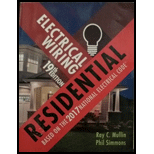
ELECTRICAL WIRING:RESIDENT.-TEXT (PB)
19th Edition
ISBN: 9781337116213
Author: MULLIN
Publisher: CENGAGE L
expand_more
expand_more
format_list_bulleted
Concept explainers
Textbook Question
Chapter 33, Problem 5R
Which conductor types are permitted to be installed exposed for array circuits? ______________
Expert Solution & Answer
Want to see the full answer?
Check out a sample textbook solution
Students have asked these similar questions
An evening meal is being prepared in a home kitchen containing an electric oven and a microwave oven. The cost for electricity in the home's neighborhood is $0.15 per kilowatt hour. The microwave oven is specified as a 1000 watt unit, while the oven requires 240 volts and uses a current of 30 amperes to cook at 350 degrees Fahrenheit. A frozen meal can be cooked in the microwave oven set on full power in 10 minutes. The same frozen meal cooked in the electric oven set for 350 degrees F takes 40 minutes.
(a) How much energy does it take to cook the frozen meal in the microwave at full power and how much does it cost?
(b) How much energy does it take to cook the frozen meal in the electric oven at 350 degrees Fahrenheit and how much does it cost?
Don't use ai to answer I will report you answer
An electrical substation had a sudden discharge arc event lasting 0.005 seconds. The event produced 768,000 volts that conducted 500 amperes to a nearby grounded metal strap and opened a 500 ampere protective breaker.
(a) How much power was produced by the electrical discharge?
(b) How much energy was in the discharge?
(c) How long could a 75 watt light bulb stay lit, if all the energy in the arc was used to operate it?
Chapter 33 Solutions
ELECTRICAL WIRING:RESIDENT.-TEXT (PB)
Ch. 33 - Prob. 1RCh. 33 - Prob. 2RCh. 33 - Name four electrical hazards associated with...Ch. 33 - Name five components of a utility-interactive...Ch. 33 - Which conductor types are permitted to be...Ch. 33 - To size conductors and overcurrent devices for...Ch. 33 - When is a metallic raceway required for...Ch. 33 - Photovoltaic modules that also serve as an outer...Ch. 33 - Grounding electrode system requirements for a...Ch. 33 - The two methods permitted for connection of a...
Knowledge Booster
Learn more about
Need a deep-dive on the concept behind this application? Look no further. Learn more about this topic, electrical-engineering and related others by exploring similar questions and additional content below.Similar questions
- I need help with this problem and an explanation of the solution for the image described below. (Introduction to Signals and Systems)arrow_forwardFind Rth at open terminals using a 1V test source.arrow_forwardI need help with this problem and an explanation of the solution for the image described below. (Introduction to Signals and Systems)arrow_forward
- How many atoms are there in a simple cubic unit cell? in a bcc unit cell? in a fcc unit cell? in the unit cell characterizing the diamond lattice?arrow_forwardConsider the homogeneous RLC circuit (no voltage source) shown in the diagram below. Before the switch is closed, the capacitor has an initial charge go and the circuit has an initial current go- R 9(1) i(t)↓ After the switches closes, current flows through the circuit and the capacitor begins to discharge. The equation that describes the total voltage in the loop comes from Kirchoff's voltage law: L di(t) + Ri(t)+(0) = 0, (1) where i(t) and q(t) are the current and capacitor charge as a function of time, L is the inductance, R is the resistance, and C is the capacitance. Using the fact that the current equals the rate of change of the capacitor charge, and dividing by L, we can write the following homogeneous (no input source) differential equation for the charge on the capacitor: 4(1) +29(1)+w79(1)=0, ཀྱི where a= R 2L and The solution to this second order linear differential equation can be written as: 9(1) =Aent - Beat, where (3) (4) (5) A= (81+20)90 +90 (82+20)90 +90 and B= (6)…arrow_forwardConsider the homogeneous RLC circuit (no voltage source) shown in the diagram below. Before the switch is closed, the capacitor has an initial charge go and the circuit has an initial current go. R w i(t) q(t) C н After the switches closes, current flows through the circuit and the capacitor begins to discharge. The equation that describes the total voltage in the loop comes from Kirchoff's voltage law: di(t) L + Ri(t) + (t) = 0, dt (1) where i(t) and q(t) are the current and capacitor charge as a function of time, L is the inductance, R is the resistance, and C is the capacitance. Using the fact that the current equals the rate of change of the capacitor charge, and dividing by L, we can write the following homogeneous (no input source) differential equation for the charge on the capacitor: ä(t)+2ag(t)+wg(t) = 0, (2) where R a 2L and w₁ = C LC The solution to this second order linear differential equation can be written as: where 81= q(t) = Ae³¹- Bel 82 = (3) (4) (5)arrow_forward
- I need help with this problem and an explanation of the solution for the image described below. (Introduction to Signals and Systems)arrow_forwardFind Rth at open terminals using a 1V test source.arrow_forwardI need help with this problem and an explanation of the solution for the image described below. (Introduction to Signals and Systems)arrow_forward
arrow_back_ios
SEE MORE QUESTIONS
arrow_forward_ios
Recommended textbooks for you
 EBK ELECTRICAL WIRING RESIDENTIALElectrical EngineeringISBN:9781337516549Author:SimmonsPublisher:CENGAGE LEARNING - CONSIGNMENT
EBK ELECTRICAL WIRING RESIDENTIALElectrical EngineeringISBN:9781337516549Author:SimmonsPublisher:CENGAGE LEARNING - CONSIGNMENT

EBK ELECTRICAL WIRING RESIDENTIAL
Electrical Engineering
ISBN:9781337516549
Author:Simmons
Publisher:CENGAGE LEARNING - CONSIGNMENT
Inside Wireless: Antenna Array; Author: RF elements s.r.o.;https://www.youtube.com/watch?v=vuz5zwbruTQ;License: Standard Youtube License